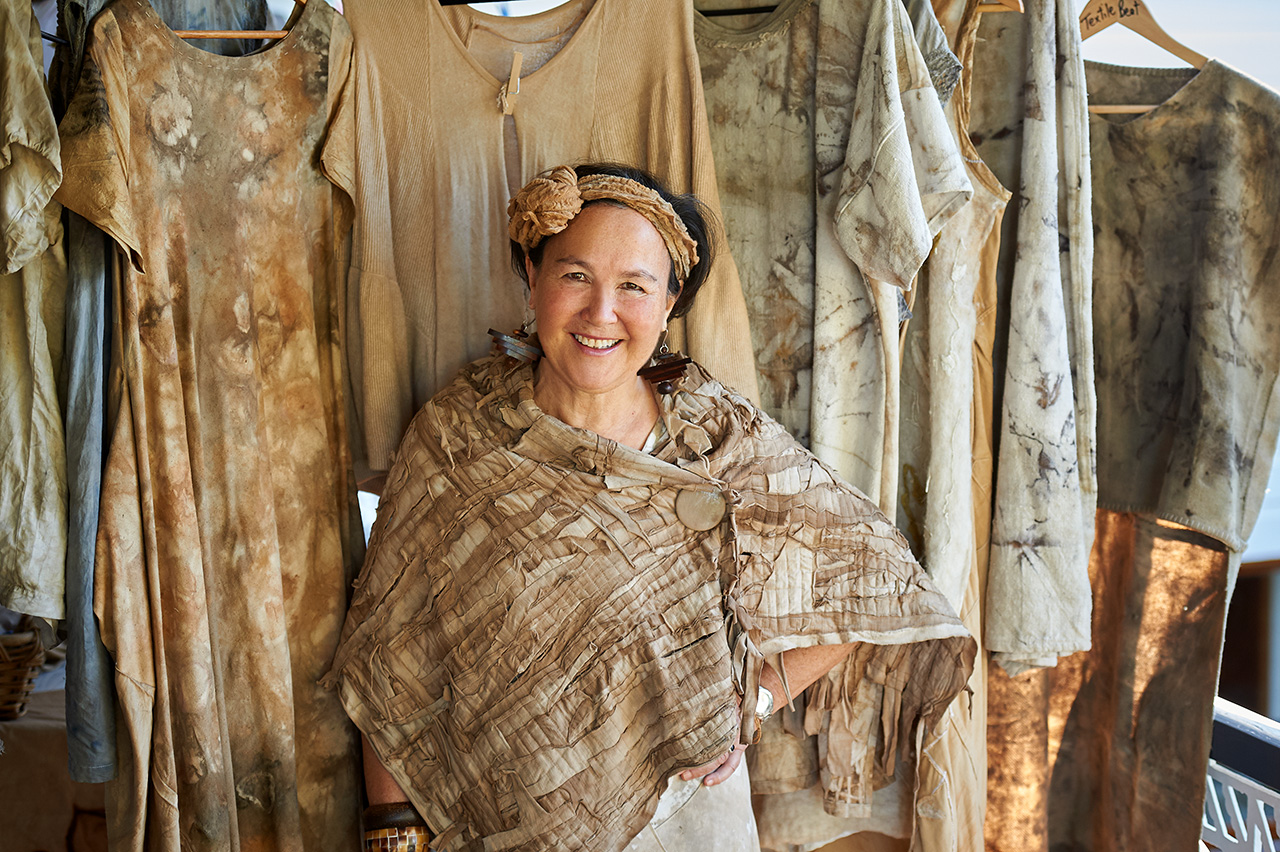Rethinking the way we live, work and play is happening as we adapt to the uncertainty and profound changes coming down the line with coronavirus. We can calm ourselves by focusing energy on living with creativity, simplicity and integrity, rather than worrying about distant unknowable possibilities.
Wabi sabi is a gentle approach to life embedded within Japanese culture that has its roots in Zen philosophy. As I (Jane Milburn) read more about wabi sabi during lockdown, it struck me as a way of living in tune with nature rather than seeking to control, manage and exploit it.

Jane Milburn wearing garments made from natural fibres coloured by leaves and bark. Photo by Patria Jannides.
At a time when we need to be adaptive and resourceful, wabi sabi is a salve that enables us to find beauty in what is around us, in all its imperfection and impermanence.
In Wabi Sabi: Timeless wisdom for a stress-free life, Swedish lecturer Agneta Winqvist writes that wabi stands for everything that we wish for that can’t be bought with money, while sabi stands for the passage of time. When ‘wabi’ and ‘sabi’ are matched, a quality is born that translates into ‘humble beauty’ and is a counterpoint to ’too much’. Wabi sabi is based on nature and circulates around three principles: nothing lasts forever, nothing is perfect, and nothing is ever finished.
English adventurer Beth Kempton writes in Wabi Sabi: Japanese wisdom for a perfectly imperfect life that what we need right now is a new way of seeing the world and our place within it.
“We need new approaches to life’s challenges. We need tools for intentional and conscious living and a framework for deciding what really matters to us, so we can move on from the constant desire for more, better, best. We need to find ways to slow down, so life does not rush right past us. We need to start noticing more beauty to lift our spirits and keep us inspired. We need to give ourselves permission to let go of judgement and the endless pursuit of perfection. And we need to start seeing each other – and ourselves – for the perfectly imperfect treasures that we are.”
Wabi sabi is understated and mysteriously undefined, yet it intrinsically encompasses a cache of wisdom that values tranquility, harmony, beauty and imperfection that can build our resilience at this time. It gives us permission to be ourselves. It encourages us to do our best but not make ourselves unhappy in pursuit of the unattainable goal of perfection.
Kempton writes that wabi sabi teaches us to be content with less, in a way that feels like more:
- Less stuff, more soul
- Less hustle, more ease
- Less chaos, more clam
- Less mass consumption, more unique creation
- Less complexity, more clarity
- Less judgement, more forgiveness
- Less bravado, more truth
- Less resistance, more resilience
- Less control, more surrender
- Less head, more heart
Australian journalist and author Julia Baird, in Phosphorescence: on awe, wonder and things that sustain you when the world goes dark, writes about wabi sabi as the sheen of antiquity, the patina of a life lived. Finding beauty in the modest, rustic, imperfect and the impermanence of all things.
In Wabi-sabi for Artists, Designers, Poets and Philosophers, Leonard Koren writes that wabi sabi means treading lightly on the planet and knowing how to appreciate whatever is encountered, no matter how trifling, whenever it is encountered. “In other words, wabi sabi tells us to stop our preoccupation with success – wealth, status, power and luxury – and enjoy the unencumbered life.“
The material qualities of things wabi sabi are visibly vulnerable to the effects of weathering and human treatment. Their chips, mends, dents, peelings and other forms of attrition are a testament to histories of use and misuse. Koren said that although things wabi sabi may be on the point of dematerialization – extremely faint, fragile or desiccated – they still possess an undiminished poise and strength of character. They are indifferent to conventional good taste. Things wabi sabi are unpretentious, understated and unassuming, and easily coexist with the rest of their environment. Things wabi sabi have no need of the reassurance of status or the validation of market culture. They have no need for documentation or provenance. It has overtones of what interior designers such as Rachel Ashwell refer to as shabby chic.
I am understanding that the upcycled natural-fibre clothing in my wardrobe have all the hallmarks of wabi sabi. They are derived from nature, imperfect, mended, modest and always works in progress. I’ve used natural colour (bark, leaves, and food waste including passionfruit and onion skins) and various stitching techniques to evolve them for fresh life. I do this for originality, sustainability and purpose. It is not that I can’t afford new, more that reusing natural fibres already in the world is the right thing to be doing at this time of uncertainty, ecological stress and fashion excess.
This article first published in Ruth Magazine Spring 2020 Issue 32